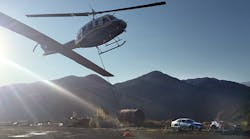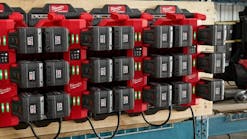Linemen often work in rugged, remote terrain, and during the recent Sand Fire restoration in California, it was no exception. When the wildfire burned into Southern California Edison’s (SCE’s) hard-to-reach territory, the utility turned to its Air Operations team, which assisted crews with restoration efforts in the back country of the Santa Clarita Valley.
The fire started on the shoulder of the northbound 14 freeway in Santa Clarita, California. After initially burning to the south into the Angeles National Forest, it reversed direction on the second and third day. It then burned to the northeast and northwest into an area about 35 miles northwest of Los Angeles.
While investigators determined the cause of the fire, SCE’s crews quickly sprang into action to help rebuild incinerated infrastructure and restore power. Meanwhile, the Air Operations department, which is responsible for overseeing a 50,000-sq-mile territory, was on hand to provide support to the field crews.
Getting Aerial Support
As part of the restoration effort, SCE’s Air Operations team flew two AS-350B3 and one Bell 205 A1+ helicopters, which airlifted distribution equipment, set poles and conducted a sock line pull. During the restoration, linemen set 30 poles and pulled 24 spans of wire with the help of helicopters. On the project, SCE used 43 crews, and by having the helicopters, it helped the distribution crews rebuild the infrastructure in a safe and efficient manner. Because of the inaccessible terrain, the helicopters proved to be very valuable.
Additionally, the pilots conducted water drops to suppress ash to help ground crews work without the dust flaring up. During the restoration, the linemen had to watch out for “ash pots,” which appear as normal ground, but are actually piles of hot ash from the fires.
Assessing Damage
The Sand Fire, which was named after the Sand Canyon, damaged about 270 structures on five distribution circuits. Multiple H-frame structures were damaged in the fire.
The H-frame structures, which are two-pole structures used for 800 ft or longer spans of conductor, are usually in remote areas with long wire span lengths from ridge to ridge. The damaged H-frame structures in this event occurred on the Little Tujunga 2.4-kV circuit, Phython 16-kV circuit and Sand Canyon 16-kV circuit.
To determine the extent of damage to SCE’s infrastructure, the utility sent 14 damage-assessment teams (DATs) from all eight of the company’s regions in advance of the field workforce. These two-person teams, who often work for the planning department, report to the storm DAT team supervisor, who gives them their work assignments.
Once the area has been deemed “safe to enter for assessment” by the local authorities and fire department, the teams are sent into the known damaged areas to assess the damage. After surveying the areas, they report back to the DAT team supervisor with their detailed assessment. Next, the supervisor assigns a planner to complete the storm work order package.
Because public and employee safety is paramount, SCE does not send employees into areas where the fire is actively burning. However, as soon as an area has been cleared, the company sends its DAT teams and local supervisors in to assess. The crews then start by identifying hazards, removing the hazards, digging the pole holes, installing the poles and then replacing the overhead wires.
Staying Safe
Following the Sand Fire, the damage was in very remote areas, accessible only by foot. To keep safe in the fire-stricken zone, the field crews relied on their knowledge as well as constant communication with one another. For example, each 16-hour work day started with a 6:30 a.m. tailboard briefing at the Magic Mountain lay-down yard. During this meeting, the workers received information from the management, safety, environmental and air operations groups.
Then once the crews arrived at their assigned job location, they conducted a task-specific tailboard briefing that included their individual job assignments, hazards of the job and how to overcome them, the status of the lines and the necessary personal protective equipment.
Also, they reviewed their Accident Prevention Manuals for rules that applied to their task at hand. While working, the crews used the S.T.O.P (Stop. Think. Observe. Perform.) method to halt the job if a hazard needed to be mitigated.
Confronting Hazards
On this restoration project, the field crews faced multiple hazards, including temperatures as high as 104 degrees. To overcome the heat, the crews stayed hydrated and took shade breaks when necessary. The supervisors also constantly stressed the critical importance of hydration and watching out for one another. Because the linemen understood that heat-related illness must be caught early, they continually observed each other’s conditions.
To overcome the obstacle of the terrain, the crews only worked during daytime hours, and each employee had to wear the proper footwear. In addition, they worked in teams to assess the areas while carrying heavy tools, and sometimes, they also used a safety rope to assist with ascending or descending difficult areas.
In addition, the restoration personnel faced other hazards such as bees, snakes and poison oak along with displaced wildlife, fire-weakened trees or snags, rolling rocks on steep slopes and emergency response vehicles.
The Sand Fire, which consumed more than 41,432 acres, was fully contained on August 9. As a result of the fire, about 90 residents lost power and more than 300 people were evacuated from their homes. By focusing on the safety of the field crews and involving its Air Operations team, however, SCE was able to respond to the fire damage swiftly to restore power and replace infrastructure.
Editor’s note: Contributing to this story were James Meis, Troy Whitman and Tobjorn “TC” Corell. Meis, manager of the Valencia, California, district for Southern California Edison, has worked for the company for the past 28 years and has served as a groundman and a lineman. Whitman, the fire management officer for SCE, has managed fire events for SCE for 23 years and is the first point of contact for first responders. He helps keep SCE personnel informed of fire details, assesses damages and determines when it’s safe to go in and start restoring power. Corell, chief pilot at SCE, oversees training and regulations for SCE’s flight division, which operates a fleet of EC135s, AS350 B3s and a B205 A1+ helicopters. A 24-year veteran of the helicopter industry with more than 12,200 hours of flight time, he joined SCE in 2005 and has been chief pilot since 2007.
View a video clip of SCE’s Air Operations and crews responding to the Sand Fire. Also Visit www.tdworld.com to view a photo gallery of the restoration project.







